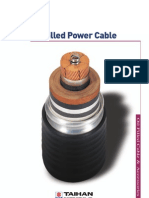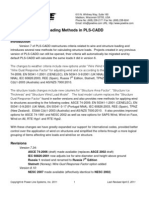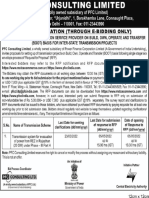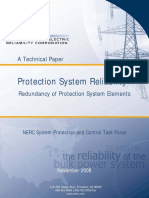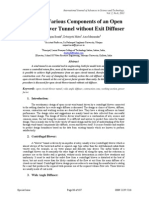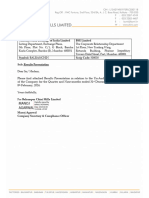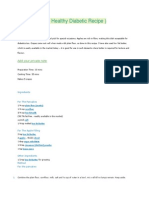Cigre Comparison HTLS
Cigre Comparison HTLS
Uploaded by
Jose ValdiviesoCopyright:
Available Formats
Cigre Comparison HTLS
Cigre Comparison HTLS
Uploaded by
Jose ValdiviesoCopyright
Available Formats
Share this document
Did you find this document useful?
Is this content inappropriate?
Copyright:
Available Formats
Cigre Comparison HTLS
Cigre Comparison HTLS
Uploaded by
Jose ValdiviesoCopyright:
Available Formats
Practical comparison
of powerline uprating and upgrading results
Greg Landwehr*, Pierre Marais,
Trans-Africa Projects (TAP) (Pty) Ltd, South Africa
Abstract To what extent do resistive losses influence the total
operational cost?
Studies for the uprating and upgrading of overhead
transmission lines (OHTL) typically yield significantly How does uprating compare to the cost of a line
different increases in transfer capacity, with equally breakdown and rebuild on the same servitude, assuming
disparate associated costs. Using a recently completed the network will allow the increased outage times?
uprating case study as a basis, commentary is given on How do voltage upgrades compare with uprating the line
the relative advantages and disadvantages of different (assuming upgrade from 88kV to 132kV)?
options considered in the study.
These options will be compared to each other in respect
A number of different High Temperature Low Sag of both the TIC, including operational Cost of Losses
(HTLS*) conductors are evaluated, as well as thermal (TOC) and Capital Investment Cost (CIC), as well as the
uprating of existing infrastructure, rebuilding and relative cost per MVA gained for each option.
voltage upgrade options.
Note: This report is based on a particular case study
The relative Total Investment Cost (TIC) versus MVA with specific constraints and care should be taken in
benefit above the base case of each option is discussed extrapolating the results to other scenarios.
and practical selection methods are given which will
result in the most cost efficient strategy for the utility.
2. Case Study
The work methodology that was used is discussed,
including lessons learnt during the study. The OHTL chosen for this case study is a 24km,
88kV, single circuit, Wolf ACSR powerline between
Hlungwana substation and Normandie substation. The
1. Introduction powerline is situated in the North of the Kwa-Zulu Natal
A case study is presented in which the uprating and province in South Africa and near the Swaziland border.
upgrading results for a specific 88kV line are discussed. 2.1. Synopsis of existing powerline
The research in this case study attempts to answer the
The existing 88kV network is strung with Wolf
following investigation questions:
Aluminium Conductor Steel Reinforced (ACSR) and
What increases can be obtained with low cost options a 7/2.65 steel earthwire, with lattice tower supports as
such as re-rating? shown in the figure below.
How do currently available HTLS conductor options The powerline was originally templated at 50°C.
compare with each other with respect to installation costs? The Wolf ACSR conductor is limited to a Maximum
*gregory@taprojects.co.za
KEYWORDS
High-Temperature-Low-Sag Conductors, Thermal Limit, Uprating, Upgrading, Rebuild, Re-conductoring
NOMENCLATURE
Abbreviations (see abbreviations on the last page followed by the references)
Cigre Science & Engineering • N°5 June 2016
50
Allowable Conductor Temperature (MACT) of 90°C to For each of the simulations considered, a cut-off MACT
avoid annealing of the aluminium strands. was chosen to satisfy a minimum number of clearance
2.2. As-Built Modelling Process violations that can be remedied by simple movement
of underpass low voltage lines or slight retensioning of
An as-built model of the existing Normandie – conductor.
Hlungwana 88kV powerline was created in PLS-Cadd ©.
The as-built model is used to determine actual structure 2.4. Technical Results
capacities, swing angle limits and clearance limits. For each of the technical options outlined below,
To create the as-built model, LiDar data was acquired particular Catenary value limits have been used as shown
showing survey points for the complete powerline. in the table below. These have been chosen to correlate
with the type of conductor behaviour.
Following the LiDar data acquisition and feature coding,
the PLS-Cadd © method 1 structure seed files were Conductor Maximum
Weather case
spotted at the as-built positions. Name Catenary (m)
Following the tower spotting, Wolf conductor was Wolf ACSR EDT No Wind @ 15oC 1750*
strung and graphically sagged in PLS-Cadd © to the ACCC
EDT No Wind @ 15oC 1800**
LiDar representative conductor position. To be able to Copenhagen
assign the correct conductor temperature, an Ampacity ACSS/TW Oriole EDT No Wind @ 15oC 1900
study was completed. Using the method outlined in the ACCR Linnet EDT No Wind @ 15 C o
2000
“Cigre Technical Brochure 207: Thermal behaviour GZTACSR Hawk EDT No Wind @ 15oC 2100
of overhead conductors” - Section 1 - Steady State, the ZTACIR Hawk
EDT No Wind @ 15oC 2100
core temperature of the conductor was then calculated at Equivalent
38.8°C. A sample representation of the as-built model on * As installed
the day that the LiDar survey was then completed. **ACCC could be strung at a higher C-value, but will not need any higher
tensions due to its low expansion coefficient
Following this temperature assignment, weather cases
Table 1: Conductor Performance Limits (PLS-Cadd ©)
were created for temperatures from 50°C up to 240°C
in increments of 10°C to cater for all possible conductor 2.4.1. Increasing the thermal limit of the existing conductors
models needed for simulation. (Re-rating)
2.3. Available uprating and upgrading options The existing conductor is Wolf ACSR at 88kV templated
at 50oC. This model is considered the base case for all
Most existing powerlines have bare, stranded conductors
other simulations and results in a power transfer capacity
consisting of nearly pure, worked hardened aluminium
of 55MVA. After running the PLS-Cadd Thermal Limit
wires helically stranded over a stranded steel core. These
Report © to a maximum thermal rating of 90°C, the
ACSR conductors are typically limited to a MACT
Wolf ACSR performed well showing only one minor
of 75°C to 100°C [1] whereas HTLS conductors are
clearance violation at 132kV. Because of excess ground
typically limited to temperatures in the order of 150-
clearance available, re-tensioning was not required at
210°C.
either 88kV or 132kV (This amount of excess clearance
To achieve the increased power transfer requirement, is relatively uncommon, and re-tensioning would
there are several options which have been explored: normally be required).
• Increasing the thermal limit of the existing conductors Note: The re-rating of the line to an operating temperature of 90°C would
be subject to a probabilistic analysis to confirm that any annealing
• Upgrading the voltage level of the existing conductors would fall within acceptable limits.
• Replacement (breakdown and rebuild) of the existing
2.4.2. Replacing ACSR conductors with AAAC conductors
OHTL with a new OHTL
• Re-conductoring the existing powerline with HTLS Replacement of the existing Wolf ACSR conductor
conductors with equivalently sized Canton AAAC yielded increased
Cigre Science & Engineering • N°5 June 2016
51
capacity, but not more than those achieved with a re- reinforced aluminium matrix composite core, which
rated ASCR solution. This is due to the fact that the contributes to the tensile strength of conductor and its
linear expansion coefficient of the AAAC is 21% higher electrical conductivity characteristics. The composite
than the ACSR, making it unsuitable for use at elevated core has a lower thermal elongation property, which
temperatures. The AAAC was thus not taken further in contributes to reduce the sag characteristics at higher
this study. operating temperatures [5].
2.4.3. Rebuilding a new OHTL
2.4.4.4. GZTACSR Hawk
The breaking down and replacement of an OHTL with
GZTACSR (Gap-type heat resistant aluminium alloy
one carrying a heavier conductor or higher voltage is a
(Aluminium Zirconium) Conductor Steel Reinforced)
possibility which is normally dependent on the resilience
has a small gap between the outermost edge of the
of the network, and could be included if such construction
steel core and the innermost side of the trapezoidal-
is possible. The replacement of the OHTL with higher
shape aluminium alloy layer such that the steel core
capacity conductors would yield the capacities outlined
in figure 1 (standard templating temperature of 70°C can move independent from the aluminium alloy layers.
assumed). Consequently, the design of the aluminium conductor is
such that the steel core carries the full tensile load during
2.4.4. Re-conductoring the existing powerline with HTLS
high temperature conditions. However, during lower
conductors
conductor temperatures, the aluminium alloy contributes
Replacing existing installed conductors with an HTLS in carrying the tensile load at the associated weather
type, having a lower thermal elongation rate, less sag, a conditions [5].
similar overall conductor diameter and similar resistance
2.4.4.5. ZTACIR Hawk Equivalent
values, can be an attractive option where uprating of an
existing line is being considered [5]. ZTACIR (extra heat resistant aluminium alloy (ZT-
2.4.4.1. ACSS/TW Oriole Aluminium) Conductor Invar Reinforced) is similar to
ACSR but having a high strength invar alloy core. The
ACSS/TW (Aluminium Conductor Steel Supported/ conductor has a relatively low sag characteristic at high
Trapezoidal Wire) comprises of fully annealed aluminium temperatures a result of the small linear coefficient of
wires stranded over a core of high-strength steel stranded thermal expansion of the invar [5]. Given the relatively
wire, with the thermal expansion properties being similar high cost of Invar conductors, and the fact that ground
to that of ACSR. ACSS is typically available with standard clearance issues are less critical in this case study, we
round strands as well as trapezoidal aluminium wire, where
would not expect an Invar conductor to compete well in
the trapezoidal shaped strands provide greater conductive
this instance.
aluminium area with much smaller interstices [5].
2.4.5. Summary of Results
2.4.4.2. ACCC Copenhagen
The above simulation results are summarised per voltage
ACCC (Aluminium Conductor Composite Core) consists
in the figure below. It is clear that if re-conductoring is
of a lightweight circular-shaped composite core with a high
performance, fully annealed aluminium stranding around chosen, at both voltages that GZTACSR Hawk, ACCC
the core. The significantly lower thermal elongation Copenhagen and ZTACIR Hawk equivalent, provide
property of these conductors contributes to much less sag the best increase in power transfer whilst adhering to
in comparison to other HTLS type of conductors [5]. the clearance requirements and structural limits of the
existing support structures. A Twin Kingbird ACSR
2.4.4.3. ACCR Linnet upgrade also provides a very attractive option however,
ACCR (Aluminium alloy Conductor Composite this would involve a completely new powerline rebuild
Reinforced) is constructed with a heat-resistant aluminium (i.e. break down and re-use the existing servitude) as
alloy (Zirconium Aluminium) and a proprietary fibre- opposed to only re-conductoring with HTLS conductors.
Cigre Science & Engineering • N°5 June 2016
52
Figure 1: Summary of Maximum MVA Transfer per conductor type
2.5. Economic Feasibility Rt = R0 ( 1 + α (t – t0 ) ) (1)
To quantify the relative costs of the different options, Rac = sp × sk × Rdc (2)
an economic analysis has been conducted based on the
Where:
technical results shown above.
Rt = is the DC resistance at temperature t in °C
2.5.1. Uprating and upgrading Economic Process
R0 = is the DC resistance at the base temperature T
Several of the available options may not support the
quoted on the conductor datasheet
required MVA load after year 18. For the purposes of this
study, the normal investment period of 25 years (used α = the temperature coefficient of resistance taken
for life cycle cost calculations) has been shortened to 18 as 0.004308 [17]
years to enable comparison between the alternatives. sp = the spiralling effect multiplier taken as 1.02
Based on the load profile, the TIC for the following [18] **
viable options have been considered: sk = the skin effect multiplier **
3 Increasing the thermal limit of the existing ACSR Rac = is the final AC resistance after applying the
Wolf multipliers
4 Re-conductoring the existing powerline with: Rdc = is the DC resistance to which the multipliers
• ACSS Oriole TW are applied (in this case at 20°C)
• GZTACSR Hawk
• ZTACIR Hawk Equivalent Calcu-
Calculated
• ACCR Linnet DC Value AC 88kV
lated AC
• ACCC Copenhagen 132kV
@ 20°C Value @
Value
–Manu- max opp.
5 Breakdown and Rebuild of the existing powerline Parameter Value
facturer temp using
@ max
with: opp. temp
datasheet (1), (2)
using (1),
• Single Kingbird ACSR (Ω/km) above (Ω/
(2) above
• Twin Kingbird ACSR km)
(Ω/km)
Furthermore, a voltage upgrade from 88kV to 132kV has Interest/ 7.8%*
been considered in each case. discount
rate for CIC/
2.5.2. Uprating and upgrading Economic Results TOC
Based on the abovementioned options, and the Rand/Dollar R12.50
economic parameters used below, the results of the Exchange per USD
economic analysis are presented. Wherever datasheets Long Range 6 US
did not supply them, AC Resistance values, per km, at Marginal cents/
the relevant temperature were calculated using the DC Cost of kWhr
Generation
Resistance values, per km at 20°C and the following (2015)
formulae [16]:
Cigre Science & Engineering • N°5 June 2016
53
Resistance 0.1828 0.2437 @ 0.2437@ 2.5.3. Summary of Results
for Wolf 90°C 90°C
ACSR
All available options include the following in their Total
Investment Cost (TIC):
Resistance 0.0891 0.2214 @ 0.2214 @
for Kingbird 75°C 75°C
1. Capital Investment Cost (CIC), including break
ACSR down of existing line for the rebuild options, where
applicable
Resistance 0.1601 0.2546 @ 0.2195 @
for Oriole 100°C 80°C Note: where upgrading of the voltage occurs from 88kV to 132kV, the
ACSS TW
substation and hardware upgrade costs are also considered
Resis- 0.1190 0.2225 @ 0.2067 @ 2. Total Cost of Losses (Total Operating Cost - TOC)
tance for 210°C 180°C
GZTACSR Resistive (I2R) losses were quantified over the investment
Hawk period of 18 years, based on the predicted daily average
Resistance 0.1352 0.2520 @ 0.2282 @ load on the line. The Kingbird ACSR rebuilds perform
for ZTACIR 210°C 170°C very well as do the HTLS options. The existing Wolf
Hawk ACSR thermal uprating options are less attractive,
Equivalent especially at 88kV, in terms of resistive losses.
Resistance 0.1596 0.2905 @ 0.2552 @
for ACCR 200°C 150°C Note: Maintenance costs, which normally are included in operational
costs, were not quantified, as these were deemed to be the same
Linnet
irrespective of the solution adopted.
Resistance 0.1272 0.2214@ 0.2214@
for ACCC 180°C 180°C
Copenhagen
*Based on Real Cost of Capital for Eskom (2015)
** Significant research is being conducted into the calculation of sp and
sk (Cigre Brochure 345) however for the purposes of this paper, the
deterministic approximation for sp and those read from the Clark/Dwight
Skin Effect curve for sk are deemed sufficient
Table 2: Economic Parameters ([7], [9] to [15])
Conductor Name Normalised Conductor Cost*
ACSR Wolf 1
ACSR Kingbird 1.2 Figure 2: Total Cost of Losses (Total Operating Cost – TOC)
ACSS Oriole TW 1.2 The most cost effective option, based on Total Investment
GZTACSR Hawk 2 Cost, is to leave the Wolf ACSR in place, increase its
thermal rating and then upgrade its voltage 132kV. The
ACCC Copenhagen 4
rebuild options are extremely competitive due to the
ZTACIR Hawk Equivalent 5 low losses experienced by Kingbird conductor. Further
capacity upgrades are possible by installing an HTLS
ACCR Linnet 5.5 conductor, with the GZTACSR Hawk being the most
* Including hardware and installation Costs likely candidate from a TIC perspective. ACSS Oriole
Table 3: Normalised Conductor Cost Factors TW also provides an attractive option however the
([8] & indicative projects completed by Trans-Africa Projects) available MVA is low.
Cigre Science & Engineering • N°5 June 2016
54
3. Conclusion
While it would be ill advised to draw conclusions
from the outcomes of a single uprating study to other
scenarios, this study has shown interesting results, and
would indicate the following guidelines:
• Technically, it has been shown that re-rating an OHTL
can result in a very low cost option for increasing
the power transfer capacity. Where there is capacity
available by up-rating and /or re-tensioning a line,
this should be explored as a first option, as it is very
cost effective, and would enable the deferral of more
expensive upgrade options to a later date.
Figure 3: Economic Feasibility Summary (TIC)
• Upgrading the line voltage or even re-building the
A more indicative metric of cost efficiency however, is line with heavier conductor at a higher voltage can
the ratio of the TIC to the increased MVA available per be more cost effective than conductor replacement
option, above the base case of 55MVA. The figure below with HTLS conductors, assuming the network can
shows this relationship per option. The Wolf ACSR is sustain the longer interruption and the substation can
still a cost effective option per MVA however, if we accommodate the voltage upgrade.
consider that after year 18, the Wolf ACSR will more
than likely, not be able to accommodate the required • Economically, available HTLS conductor options are
load, then other options become more feasible. In still expensive in terms of up front capital investment
terms of complete rebuild, the Twin Kingbird option at (i.e. re-conductoring). GZTACSR, ACCC and
132kV is the most attractive and extremely competitive. ZTACIR provide the best total increase in power
However, rebuilding a line is often prohibitive from a transfer capability whilst adhering to the clearance
network resilience / interruption perspective. The most requirements and structural limits of the existing
cost effective re-conductoring option is GZTACSR support structures.
Hawk at 132kV. Slightly more expensive but able to • GZTACSR (Gap–type) conductor emerged as the
run at higher temperatures and MVA capacities are the most cost effective HTLS conductor per MVA
ACCC Copenhagen and ZTACIR Hawk equivalent gained. Engineers would however be well advised to
options which are close behind the GZTACSR. The quantify accurately the supply and installation costs
132kV upgrade options in general outperform the 88kV with every option, as the market for HTLS conductors
options. ACSS Oriole TW, while being a relatively cost is competitive and changing.
effective option, does not offer the required capacity
increase of the other HTLS options. • Resistive losses (TOC) have a major influence on the
Total Investment Cost for all options explored. Most
notably increasing the thermal rating of an existing
ACSR powerline is completely dominated by the
cost of losses from the average daily load and, in fact,
increases its TIC to be in-line with other available
options.
From the above results, a simplified process has emerged
for increasing the power transfer of a particular OHTL.
Firstly, all thermal capacity rating increase possibilities
must be considered including retensioning. Secondly,
Figure 4: Ratio of TIC to the increased MVA [USDm]/[MVA] when the available MVA has been exhausted from thermal
Cigre Science & Engineering • N°5 June 2016
55
capacity increase, the best available options from a TIC [5] Nel, R., Transnet Coal Link Expansion: Uprating Report, Trans-
versus MVA available perspective, are then to rebuild at Africa Projects, 2015
a higher MVA capacity using a similar increased bundle [6] Thomas, N., Final Design Report – Rev 0, Transnet Freight Rail
type conductor. Thirdly, when the available MVA is 88kV Mpumalanga Lines, Eskom, December 2013
exhausted with rebuilding, GZTACSR, ACCC and [7] Matona, T., Interim integrated results for the six months ended 30
ZTACIR re-conductoring must be considered. Although September 2014, Eskom 2014
more expensive these conductors are able to run at much [8] Chan, J. et al, Demonstration of Advanced Conductors for
higher temperatures and MVA capacities which in turn Overhead Transmission Lines, Electric Power Research Institute,
July 2008
provide a much longer lifespan.
[9] I. Zamora, A.J. Mazón, R. Criado, C. Alonso, J.R. Saenz, Uprating
4. Abbreviations Using High-Temperature Electrical Conductors, University of the
Basque Country – Spain, IBERDROLA S.A, March 2014
ACCC Fully annealed Aluminium Conductor [10] AAAC Conductor Data Sheet, Southwire, April 2012
Composite Core supported
[11] ACCC Conductor Data Sheet, CTC Global, February 2014
ACCR Aluminium alloy Conductor Composite
Reinforced [12] ACCR Technical Summary, 3M, November 2011
ACSR Aluminium Conductor Steel Reinforced [13] ACSS Conductor Data Sheet, Southwire, May 2012
ACSS/TW Aluminium Conductor Steel Supported/ [14] GZTACSR Conductor Data Sheet, J-Power Systems Corp, April
Trapezoidal Wire 2015
ASL Above sea level [15] ACSR Brochure, Aberdare, 2012
CIC Capital Investment Cost
[16] William D. Stevenson, Jr, Elements of Power System Analysis,
EDT Every Day Tension Fourth Edition, McGraw-Hill, 1982.
GZTACSR Gap-type heat resistant aluminium alloy
[17] Kuphaldt, T.R., Lessons in Electric Circuits, Vol 1, 5th Ed, October
(ZT-Aluminium) Conductor Steel Rein- 2006
forced
[18] Troskie, H., Research into Specific Numerical Protection
HTLS High Temperature Low Sag
Maloperations, November 2012
MACT Maximum Allowable Conductor Tempera-
ture
MTPA Mega Tons per Annum 6. Biography
OHTL Over Head Transmission Line Greg Landwehr is currently employed as the Corporate
TFR Transnet Freight Rail Consultant for Trans-Africa Projects at their Head Office
TOC Total Operation Cost ex. Maintenance in Johannesburg. His time is focused on consulting in
TIC Total Investment Cost the field of General Overhead Transmission Line Design
TSO Transmission System Operator in South Africa and beyond its borders, with areas of
UTS Ultimate Tensile Strength interest being conductor optimisation and powerline
ZTACIR Extra heat resistant aluminium alloy (ZT- uprating and upgrading solutions.
Aluminium) Conductor Invar Reinforced
He is a registered Professional Engineer with the
5. References Engineering Council of South Africa and holds a Master’s
[1] Douglas, D., Uprating & Reconductoring Existing Lines with Degree in Renewable Energy Physics from Oldenburg
special emphasis on High-Temperature Low-Sag Conductors, University in Germany, and Bachelor of Science Degrees
Cigre Study Committee B2 Tutorial, Cape Town 2012 in Mechanical Engineering and Computer Science from
[2] Lötter, T., Badze, M., Maharaj, S., Final Design Report – Rev the University of Natal in South Africa.
0, Transnet Freight Rail 88kV Eastern Region Lines, Eskom,
December 2013 Greg is the Chairman of the South African National
[3] Eskom, Planning, Design and Construction of Overhead Standards Working Group for SANS 10280 Part 2 ‘The
Powerlines, Crown Publications, May 2010 General Design Considerations for Overhead Pow lines
[4] Candy, R., Eskom central Control, MVA Data, April 2015 for conditions prevailing in South Africa’.
Cigre Science & Engineering • N°5 June 2016
56
You might also like
- NIHSS Answer KeyDocument4 pagesNIHSS Answer KeyNathalie Caraca79% (24)
- Instruction For Laying of HV Cables PDFDocument27 pagesInstruction For Laying of HV Cables PDFts45306100% (1)
- 3406 CatDocument166 pages3406 CatBayanaka Tehnik88% (16)
- Overall Understanding CT As Per IEC 61869 2 1679333290Document11 pagesOverall Understanding CT As Per IEC 61869 2 1679333290DineshNo ratings yet
- Stability and Control-Annurev 2022 PDFDocument30 pagesStability and Control-Annurev 2022 PDFJose ValdiviesoNo ratings yet
- Surge Arrestor SelectionDocument24 pagesSurge Arrestor SelectionAdetunji TaiwoNo ratings yet
- IEEE Wind Power Plant Grounding Topics For Discussion RESDocument21 pagesIEEE Wind Power Plant Grounding Topics For Discussion RESMilomir GavrilovicNo ratings yet
- OilFilledPowerCable Catalog PDFDocument24 pagesOilFilledPowerCable Catalog PDFsamsungloverNo ratings yet
- Standard For Overhead LinesDocument23 pagesStandard For Overhead LinesHappi Gwegweni0% (1)
- Cable and OH Line in Wind Power PlantsDocument34 pagesCable and OH Line in Wind Power PlantscegorrellNo ratings yet
- Earthing of GIS Type ELK - GTIDocument20 pagesEarthing of GIS Type ELK - GTIJairo MoralesNo ratings yet
- ASA's Flight Planner InstructionsDocument9 pagesASA's Flight Planner InstructionsMCube78No ratings yet
- 3009 - Method Statement For Administration Building Construction PDFDocument38 pages3009 - Method Statement For Administration Building Construction PDFNjilou LagaticNo ratings yet
- Metagenics Patient Detox GuideDocument40 pagesMetagenics Patient Detox GuideJessica Bowman100% (2)
- Ehv Bonding CableDocument9 pagesEhv Bonding CablemazzoffaNo ratings yet
- Wind Farm EarthingDocument3 pagesWind Farm EarthinggioutsosNo ratings yet
- NGTS 201 Issue2 PDFDocument27 pagesNGTS 201 Issue2 PDFjuanluismartosNo ratings yet
- NEPAL MASTER PLAN REPORT OHL Standards PDFDocument55 pagesNEPAL MASTER PLAN REPORT OHL Standards PDFAshish Regmi100% (1)
- Midspan Clearance Calculation REV.01Document8 pagesMidspan Clearance Calculation REV.01Sarfaraz Ahmed Brohi100% (1)
- Layout and SLDDocument30 pagesLayout and SLDmeraat100% (1)
- Tech Spec 132KV LineDocument285 pagesTech Spec 132KV LineSanjay Rout0% (1)
- 12-II.2. Tower SpottingDocument16 pages12-II.2. Tower Spottingashok10577No ratings yet
- AusNet Services - AMS 10-60 - Earth Grids - Non Confidential - October 2015Document12 pagesAusNet Services - AMS 10-60 - Earth Grids - Non Confidential - October 2015andyhilbertNo ratings yet
- Areva's Earthing Recomondation For GISDocument10 pagesAreva's Earthing Recomondation For GISraghavendran raghu100% (1)
- OverheadDocument31 pagesOverheadMehulNo ratings yet
- NGR Technical InformationDocument6 pagesNGR Technical InformationPrabakar PNo ratings yet
- CIGRE 2008 A3-207 Int ArcDocument10 pagesCIGRE 2008 A3-207 Int Arcdes1982No ratings yet
- Major Substation Earthing Layout DesignDocument37 pagesMajor Substation Earthing Layout Designjaimito=)100% (1)
- Insulation Coordination Studies For A 132 KV Submarine Cable InterconnectionDocument4 pagesInsulation Coordination Studies For A 132 KV Submarine Cable InterconnectionJjjjpf100% (1)
- Loading Methods in PLS-CADDDocument17 pagesLoading Methods in PLS-CADDSimonckloh100% (1)
- Wind Power Plant Collector System Design - SCRDocument7 pagesWind Power Plant Collector System Design - SCRLuis FebresNo ratings yet
- Earthing 2015 NewDocument4 pagesEarthing 2015 Newravi shankarNo ratings yet
- Substations High Level Design Criteria GuidelineDocument7 pagesSubstations High Level Design Criteria Guidelinepraveshkafle100% (1)
- Technical Specifications of SubstationDocument3 pagesTechnical Specifications of SubstationthibinNo ratings yet
- مشروع المحطات بهندسه حلوان PDFDocument315 pagesمشروع المحطات بهندسه حلوان PDFMohamedAhmedFawzy0% (1)
- OHL Manual Vol.2 Drawings & Reference Info v3 July 2006Document190 pagesOHL Manual Vol.2 Drawings & Reference Info v3 July 2006somchak2000100% (2)
- PHE SPE ELE 311 Substation Hardware SwitchyardDocument26 pagesPHE SPE ELE 311 Substation Hardware Switchyardminecrf project and mining chennelNo ratings yet
- KEC International Limited: Power T & D Cables Railways Civil SolarDocument42 pagesKEC International Limited: Power T & D Cables Railways Civil SolarPlanning Engineering100% (1)
- "Design of EHV Switchyard": Jayanth Kumar Boppa Executive Engineer Electrical Design Npcil, MumbaiDocument47 pages"Design of EHV Switchyard": Jayanth Kumar Boppa Executive Engineer Electrical Design Npcil, Mumbaipraveen_1324100% (2)
- Design of 220 KV Substation Grounding GridDocument7 pagesDesign of 220 KV Substation Grounding GridFaisal MoinNo ratings yet
- Major Components of The HVDC Converter Station (Single Line Diagram Explained)Document12 pagesMajor Components of The HVDC Converter Station (Single Line Diagram Explained)Iyung RuslanNo ratings yet
- ClearanceDocument42 pagesClearanceVijaya RekhaNo ratings yet
- 4.8.7 Design Drawings - 132kV Overhead LinesDocument9 pages4.8.7 Design Drawings - 132kV Overhead LinesDario SotoNo ratings yet
- Insulation Coordination PresentationDocument42 pagesInsulation Coordination PresentationAyanangshu ChakrabartyNo ratings yet
- WBN028 - B1.47 - Mar21Document63 pagesWBN028 - B1.47 - Mar21E PenaNo ratings yet
- Introduction of Sub-Station: Marudhar Engg. CollegeDocument49 pagesIntroduction of Sub-Station: Marudhar Engg. Collegesorry2qaz100% (1)
- Transmission Line TowersDocument3 pagesTransmission Line TowersSoumik Dandapat100% (2)
- ACCC Midal Data (Imperial Units) PDFDocument10 pagesACCC Midal Data (Imperial Units) PDFYusroni NainggolanNo ratings yet
- CBIP - Earthing of AC Power Systems - Pub. No. 339 - 2018Document46 pagesCBIP - Earthing of AC Power Systems - Pub. No. 339 - 2018Ayan BanerjeeNo ratings yet
- Specification - PLCC & FOTE JewarDocument20 pagesSpecification - PLCC & FOTE Jewarscada.wupptcl0% (1)
- 132kV Network ReconfigurationDocument35 pages132kV Network ReconfigurationAkinwumi OluwatosinNo ratings yet
- Substation Auxiliary Power - SSVTDocument75 pagesSubstation Auxiliary Power - SSVTdono26100% (1)
- STNW3355 - V4 Subtransmission Line Design Manual PDFDocument147 pagesSTNW3355 - V4 Subtransmission Line Design Manual PDFvitorNo ratings yet
- Cable Ampacity and AnalysisDocument6 pagesCable Ampacity and Analysisraja kumarNo ratings yet
- Family of Low Height 380KV Overhead Transmission Lines Lattice Steel StructuresDocument23 pagesFamily of Low Height 380KV Overhead Transmission Lines Lattice Steel StructuresMaein AbreenNo ratings yet
- Using Lidar Survey To Release Line Capacity: A Western Power Distribution Case StudyDocument2 pagesUsing Lidar Survey To Release Line Capacity: A Western Power Distribution Case StudyoscarilloNo ratings yet
- 02 - Thermal Rating Implications of The Co-Location of HV Cable Circuits in TunnelsDocument5 pages02 - Thermal Rating Implications of The Co-Location of HV Cable Circuits in Tunnelssaghaee.rezaNo ratings yet
- Cable Ampacity Calculation and Analysis for PowerDocument6 pagesCable Ampacity Calculation and Analysis for Powerpr0ustNo ratings yet
- Cable Ampacity Calculation and Analysis For Power Flow OptimizationDocument6 pagesCable Ampacity Calculation and Analysis For Power Flow OptimizationRiyadh ZakiNo ratings yet
- Fdok Ls Fdok RD DH JSFVR Oksyvst Osq LKFK Fo - QR Osqcy DH Vuq'Kaflr 'KKVZ Js VX Fof'Kf"VDocument9 pagesFdok Ls Fdok RD DH JSFVR Oksyvst Osq LKFK Fo - QR Osqcy DH Vuq'Kaflr 'KKVZ Js VX Fof'Kf"VAshish bhattNo ratings yet
- IEEE-TPC RatingWith738 26july2010 PDFDocument28 pagesIEEE-TPC RatingWith738 26july2010 PDFbeimar_nalNo ratings yet
- Application of A Line Ampacity Model and Its Use in Transmission Lines OperationsDocument7 pagesApplication of A Line Ampacity Model and Its Use in Transmission Lines Operationsmalekpour_ahmadNo ratings yet
- Transmission Line Arresters Application For Control of SOV On 500kV TLDocument5 pagesTransmission Line Arresters Application For Control of SOV On 500kV TLaishe8No ratings yet
- 8942V 00 CN 16 12 007 1 SDocument23 pages8942V 00 CN 16 12 007 1 SAshwin SevariaNo ratings yet
- 2019 NERC-NATF-EPRI Power System Modeling Workshop Presentations PDFDocument434 pages2019 NERC-NATF-EPRI Power System Modeling Workshop Presentations PDFJose ValdiviesoNo ratings yet
- Cigre SC B4Document4 pagesCigre SC B4Jose ValdiviesoNo ratings yet
- Designing Diversified Renewable Energy Systems-2023 PDFDocument15 pagesDesigning Diversified Renewable Energy Systems-2023 PDFJose ValdiviesoNo ratings yet
- "Transmission System Strengthening Scheme Evacuation 8.1GW-765KV IndiaDocument144 pages"Transmission System Strengthening Scheme Evacuation 8.1GW-765KV IndiaJose ValdiviesoNo ratings yet
- India-PFC Consulting-765kv System-Process - Selection - Transmission - Service - Provider (2022)Document317 pagesIndia-PFC Consulting-765kv System-Process - Selection - Transmission - Service - Provider (2022)Jose ValdiviesoNo ratings yet
- 3 - Horacio Silva Saravia 2022 CIGRE NGN Paper Linear State Estimator Deployment AEPDocument8 pages3 - Horacio Silva Saravia 2022 CIGRE NGN Paper Linear State Estimator Deployment AEPJose ValdiviesoNo ratings yet
- Nepal (NEA) 1564049351 - Revised Vol II Chapter 01-PSR Wrt. Amendment No. 3Document130 pagesNepal (NEA) 1564049351 - Revised Vol II Chapter 01-PSR Wrt. Amendment No. 3Jose ValdiviesoNo ratings yet
- INTEGRATION RENEWABLE ENERGY DIST. System (1994 (Document124 pagesINTEGRATION RENEWABLE ENERGY DIST. System (1994 (Jose ValdiviesoNo ratings yet
- Paper Renewable Regulation Final Nov 2 2011 With FormattingDocument44 pagesPaper Renewable Regulation Final Nov 2 2011 With FormattingJose ValdiviesoNo ratings yet
- NERC-Protection Sistem Reliability - 1-14-09Document60 pagesNERC-Protection Sistem Reliability - 1-14-09Jose ValdiviesoNo ratings yet
- Bonneville-Transmission ACSubstations DASDocument147 pagesBonneville-Transmission ACSubstations DASJose ValdiviesoNo ratings yet
- Power Grid-India-Annexure-II-Specific-Requirement - Rev-05 - With-Annexures-1-11Document11 pagesPower Grid-India-Annexure-II-Specific-Requirement - Rev-05 - With-Annexures-1-11Jose ValdiviesoNo ratings yet
- Study of NEOM city-MSC Thesis-2018Document183 pagesStudy of NEOM city-MSC Thesis-2018Jose ValdiviesoNo ratings yet
- AEP-shared Constr Esb756Document179 pagesAEP-shared Constr Esb756Jose ValdiviesoNo ratings yet
- Deliverable REALISEGRID Hvdc-HvacDocument75 pagesDeliverable REALISEGRID Hvdc-HvacJose ValdiviesoNo ratings yet
- ABB Corporate Research, Germany: N. L. FantanaDocument4 pagesABB Corporate Research, Germany: N. L. FantanaJose ValdiviesoNo ratings yet
- Reconductoring Using HTLS Conductors. Case Study For A 220 KV Double Circuit Transmission LINE in RomaniaDocument7 pagesReconductoring Using HTLS Conductors. Case Study For A 220 KV Double Circuit Transmission LINE in RomaniaJose ValdiviesoNo ratings yet
- South African Power Pool-Transmission - Trading Study - ECA Oct.2009Document57 pagesSouth African Power Pool-Transmission - Trading Study - ECA Oct.2009Jose ValdiviesoNo ratings yet
- NS222 Major Substation Earthing Layout DesignDocument37 pagesNS222 Major Substation Earthing Layout DesignJose ValdiviesoNo ratings yet
- Cahora Bassa Generation Study. ECA Ag.2009Document34 pagesCahora Bassa Generation Study. ECA Ag.2009Jose ValdiviesoNo ratings yet
- Operations and Maintenance of Offshore Transmission AssetsDocument35 pagesOperations and Maintenance of Offshore Transmission AssetsJose ValdiviesoNo ratings yet
- Coordination Chemistry PrimerDocument2 pagesCoordination Chemistry PrimerNaveen KamatNo ratings yet
- Phy109 SyllabusDocument1 pagePhy109 SyllabusAditya ParasharNo ratings yet
- Mineral Classification and IdentificationDocument3 pagesMineral Classification and IdentificationBlackcat FreeManNo ratings yet
- Weld Inspection Check ListDocument3 pagesWeld Inspection Check ListBGRLNo ratings yet
- Psychoanalysis, Scientific Method, and PhilosophyDocument21 pagesPsychoanalysis, Scientific Method, and PhilosophyAndjela Bolta KovacicNo ratings yet
- BioceramicsDocument19 pagesBioceramicsKrishnaNo ratings yet
- I.F. 4.103 Pratimarsha NasyaDocument6 pagesI.F. 4.103 Pratimarsha NasyaHimanshi Abhi BhardwajNo ratings yet
- B4 - PDB & UPSDB ReconciliationDocument119 pagesB4 - PDB & UPSDB ReconciliationKevin M Kuruvilla UR15EE032No ratings yet
- Qty. Description CR 125-3-1 A-F-A-E-HQQE: Company Name: Created By: Phone: DateDocument2 pagesQty. Description CR 125-3-1 A-F-A-E-HQQE: Company Name: Created By: Phone: DateMohamed FathiNo ratings yet
- P31846 Eletrificador Ultra22K Unificado REV0!1!1678975121311Document2 pagesP31846 Eletrificador Ultra22K Unificado REV0!1!1678975121311SEBASTIAN CALLEJAS GONZALEZNo ratings yet
- T&C Extended Warranty - BS 4Document5 pagesT&C Extended Warranty - BS 4Keralam AnywhereNo ratings yet
- Evaluación Habilidades Motoras Orales en NiñosDocument8 pagesEvaluación Habilidades Motoras Orales en NiñosSebastián Andrés ContrerasNo ratings yet
- Nozzle FirstDocument21 pagesNozzle FirstMassive MindsNo ratings yet
- Tiger Pro 72HC: 530-550 WattDocument2 pagesTiger Pro 72HC: 530-550 WattjeniferNo ratings yet
- Design of Various Components of An Open Circuit Blower Tunnel Without Exit DiffuserDocument6 pagesDesign of Various Components of An Open Circuit Blower Tunnel Without Exit DiffuserprashasscribdNo ratings yet
- GoBench A Benchmark Suite of Real-World Go Concurrency BugsDocument13 pagesGoBench A Benchmark Suite of Real-World Go Concurrency BugskyooNo ratings yet
- Using Garlic (Allium Sativum) As Alternative Mosquito RepellentDocument23 pagesUsing Garlic (Allium Sativum) As Alternative Mosquito RepellentPaula Marie Llido100% (2)
- EssayDocument7 pagesEssayrubab azizNo ratings yet
- Low Key PhotographyDocument23 pagesLow Key PhotographyPatrick100% (2)
- 12NK90Document13 pages12NK90Iwan YogyaNo ratings yet
- Digital Supply Chain and Logistics with IoT Practical Guide Methods Tools and Use Cases for Industry Andreas Holtschulte 2024 Scribd DownloadDocument40 pagesDigital Supply Chain and Logistics with IoT Practical Guide Methods Tools and Use Cases for Industry Andreas Holtschulte 2024 Scribd Downloadpompilykenrt100% (3)
- BCML Investor Presentation - Dec 23Document33 pagesBCML Investor Presentation - Dec 23sosteniblebusinessNo ratings yet
- INTERNSHIP Report FINALDocument37 pagesINTERNSHIP Report FINALfahadNo ratings yet
- Apple Crepes (Healthy Diabetic Recipe) : Tarla DalalDocument7 pagesApple Crepes (Healthy Diabetic Recipe) : Tarla DalalRSRITHANo ratings yet
- Wayne P250AF P265F Gas Burner Spec SheetDocument2 pagesWayne P250AF P265F Gas Burner Spec SheetEdwin RodriguezNo ratings yet







